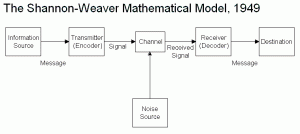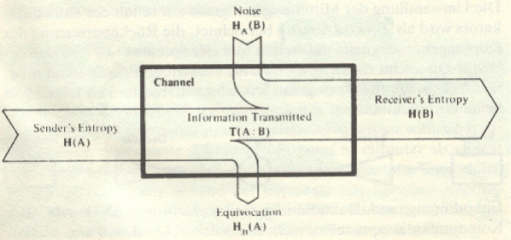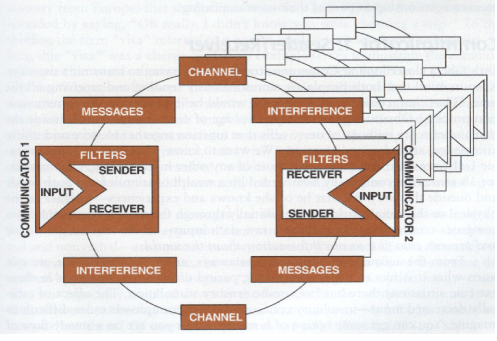Communication Defined
Learning Unit’s Contents
Communication Defined
What is Communication?
In this first online lecture we will try to answer this question.
First of all, we must analyze the word and its etymological origin:
COMMUNICATION
The word comes from Latin adjective “COMMUNIS” (common in English).
What do we need to have in “common” when we are communicating?
- We have a material or energetic connection (In our case, the vocal and hearing organs and the air through which we communicate (vocal chords generate waves in the air)
- We have also common signs, a language, which allows us to create meaning.
- We have a common knowledge, common experiences that gave a meaning to the repertoire of signs.
1 – Communication Defined
I have gathered some definitions of Human Communication. Let’s analyze them:
- Communication is the simultaneous sharing and creating of meaning through human symbolic interaction (Seiler and Beall)
- Communication is the process of human beings responding to the symbolic behavior of other persons (Adler and Rodman)
- Communication is the process of creating meaning between two or more people (Tubbs and Moss)
we need to discuss some of the key terms in those definitions:
MEANING – One of the most important concept in this course. Meaning refers to the shared experience, whichis is always generic. The individuals who have in common the English Language shared the meaning of the word “chair”. Thus, meaning is not in the words, but in the group of people who use that word.
SYMBOLS –Communication is always a symbolic interaction.
MESSAGE – It refers to the content of the symbols, i.e. the action that the symbols are replacing.
PROCESS – Communication is a process. No something static, but something dynamic. The information we exchange in this process can change us.
1.2 – Communication Contexts
Communication contexts are the different areas in which communication can occur and be studied.
We will learn several subjects, maybe too many subjects, but we will just gain a superficial vision of this research fields.
It is important to know the main statements of certain theories about Communication and certain important names. But I can’t expect from you a deep knowledge in any of them.
Important in this course is not the depth, but rather the breadth.
These different communication contexts are defined by the number of people who participate in the communication:
1.2.1 Interpersonal Communication
Basically, we talk about INTRA-personal communication when we communicate with ourselves – What we call thinking is a form of intrapersonal communication.
But also when we are thinking, i.e. communicating with ourselves, we have an interaction with others.
George Herbert Mead created to this regard the term
SYMBOLIC INTERACTION. According to Mead, we are
constantly thinking about what others may think or say about ourselves – And these thoughts determine our behavior.
As a matter of fact, the feedback we received from our social environment is the most important factor for our self-esteem.
1.2.2 Interpersonal Communication (Dyadic Communication)
Between two people – this is the basic form of communication.
This kind of Communication may be defined by the degree of closeness or intimacy between the participants.
It is usually more informal than forms of communication, more spontaneous, and there are
no fixed roles.
1.2.3 Small Group Communication
This form of Communication is normally defined as
“the process by which three or more members of a group exchange verbal or non-verbal messages in an attempt to influence one another”.
Small-group interaction occurs in social situations.
Work-groups are a good example of this form of communication – by the way. We are going to work in groups this term.
The group has to be small enough – so that every member knows the other ones – and can participate in the interaction.
Certain roles are defined in the group communication dynamic. We will learn later in this course which are those roles.
The communication has also high degree on spontaneity – but is more formal that the interpersonal communication.
1.2.4 Mass Communication
The most important feature of this form of communication
is that it is mediated. Mass Communication depends on a sophisticated technological infrastructure, which is necessary to reach masses of people.
This creates an unbalance between sender and receiver
because the sender totally control the flow of messages.
The feedback in mass communication is non-existent – or only very limited.
1.3 – Principles of Communication
1.3.1 Communication is a process of adjustment.
This basically means that, to communicate, we need to use the same system of signals. If we don’t have this in common, we will NEVER be able to communicate.
And a very important part of the process of communication will be to adapt ourselves to the system of signals of other people.
This especially evident in intercultural communication.
1.3.2 Communication is a package of messages.
And that means, according to the author, that communication always occurs in “packages” of verbal and non-verbal behaviors or messages.
Sometimes, both verbal and nonverbal messages reinforce each other, but sometimes they may be contradictory.
1.3.3 Communication involves Content and Relationship dimensions.
This basically means that communication can exist on two levels.
The speakers can communicate about something external (the weather, the situation in Iraq, a new car model, etc …)
Or the can communicate about themselves and their relationship.
1.3.4 Communication can be intentional or unintentional.
Communication is frequently intentional – we frequently have a purpose. And this purpose may be:
To learn or to teach something
To create or reinforce relationships, to interact with other individuals
To play or to enjoy or entertain yourselves
To influence or to persuade someone else.
But communication may also be unintentional.
1.3.5 Communication is inevitable, irreversible and unrepeatable
Inevitable – we cannot help it, we have to communicate.
Irreversible – you cannot un-communicate. When you have delivered a message, this message will have consequences. You can tray to reduce the effects of your message, but that means that you will have to produce new messages that will have new effects.
Unrepeatable – You cannot repeat a message, because communication will always depend on the situation and circumstances, and every form of communication will alter the circumstances, that is, the situation will be different and that will condition new messages.
.
1.4 – Misconceptions about Communication
Some myths about communication. You will find in our textbook:
Communication is a cure-all. Communication con help us resolve problems and find solutions, this is clear, AND, as I said, the way to civilization is the substitution of action by communication.
BUT communication can also create problems. And we cannot forget or ignore that communication does NOT solve the problem, the messages we create may solve problem, but if the message is not adequate, then it will make it worse.
Quantity means quality. Sometimes we can think that the more we communicate, the better.
We believe that people who can communicate easily are more friendly, competent and powerful, and have more leadership potential.
However, quantity of communication is not the same as quality.
As we said in the case of the first misconception – first myth – the quality of the message is what will determine the effectiveness.
Meaning is in the words we use. Meaning is NOT in the words means that we gave the words a meaning, and thus, the meaning of the words will always depend on the cultural background.
The meaning of words in the course of time. We construct the world with the words we use to describe it.
And our perception of the world will also be determined by the words other use to describe this world.
We have a natural ability to communicate. Like any other ability or skill, communication can be learned and should be trained.
And like in any other physical ability, even if you are a natural, you will have to work to improve the born ability.
Communication is reversible. As we saw in the last of the principles of communication. When you have delivered a message – regardless of the medium – this messages will have consequences.
2 Communication Models
In this second lecture, we will talk today about different models of the process of communication.
Models are theories that try to explain the
paradigm of communication
What is this?
The paradigm of communication?
This is simply
what happens when a form of communication – any form of communication – takes place.
A MODEL is always a description.
On the one hand, it has to be as simple and as abstract as possible.
On the other hand, it needs to be true to the reality that is being described
2.1 – Laswell’s Formula
The first Model we will learn is the so-called Laswell’s formula.
Harold D. Lasswell is a very important name in Communication Sciences,
one of the Pioneers.
In 1948, he wrote a strongly influential book
“The structure and Function of Communication in Society”.
In this book, he introduced his formula as a convenient way to describe any act of communication.
He thought that the best way to describe an act of communication was to answer the following questions:
Who? (communicator)
Says what? (message)
In which channel? (medium)
To whom? receiver – (recipient)
With what effect? (effects)
The answer to those questions was the key, in Laswell’s opinion, to explain any communicative interaction. In this way, Lawswell alsodefined the most important research fields in communication.
2.2 – Claude E. SHANNON and Warren WEAVER’s Mathematical Theory of Information
Another classic model in the field of communication.
Shannon and Weaver created with their model the foundation for the computing system that has revolutionized the world of communication.
Here is the model:

This model was thought for the technically assisted communication, for the mediated communication.
Therefore, Shannon and Weaver distinguish between information source and transmitter.
And between Destination and Receiver.
The message has to be converted – and the result, the converted information, they call SIGNAL.
So, the signal is the consequence of the Coding Process.
To understand the signal, that is the coded message, there has to be a decoding process.
CODING and DECODING are very important factors in every process of communication – constitutive features of the communication process also in the non-technical communication.
In the interpersonal (face to face) communication,
the communicator is at the same time Source and Coder.
You use the language and produce sounds.
The receiver – who is at the same time Decoder and Destination,
has to decode the acoustic signal (waves through the air) and interpret it.
A very important point in this model is the concept of NOISE.
It can be noise in the literal sense of the word (interferences on the phone), but noise
might be understood in metaphorical sense, as well, as any obstacle in the process of communication.
For example, if you have your cell phone on while reading this online lecture and check it regularly. This distraction may affect the effectiveness of a communicative act (reading my lecture).
2.3 – Klaus Krippendorff’s Model
Kripendorff is a Geman scholar teaching currently at the University of Pennsylvania.
And here is his model:

As you see, there are two different kinds of interferences – or disturbances in the process of communication.
On the one hand the noise, a term that we already discussed in Shannon and Weaver’s model.
On the other hand the Equivocation, which
this is simply the loss of information in an act of communication.
The transmitted information – also called transinformation – is the relevant information that the receiver actually gets.
Finnally, Krippendorff introduces the concept of “entropy”. This word normally refers to the degree of disorder or uncertainty in any given system. In Krippendorff’s model, “entropy” refers to the individual and unique experiences that shape our personality and that influence the meaning we give to the messages that we create, but also to those messages that we receive.
2.4- Tubbs and Moss’s Communication Model
Stewart L. Tubbs and Sylvia Moss’s Model will be the last one we will analyze in our lecture:

The latest of the models also introduces new elements that help us better understand the process of communication.
Firs of all, this is the only two-way model analyzed in this learning unit. There are no fixed roles. Everyone is at the same time sender and receiver of messages. Both are sources of communication. And therefore, the author called them communicator 1 and 2.
Both of them have an INPUT,
INPUT is a word that Tubbs and Moss borrow from the computer terminology.
In this context, INPUT means all what the communicator knows and experiences,
all the stimuli, both past and present, that give us information about the world.
The INPUT is the information and experience we have at our disposal when we create messages. To this regard, INPUT is comparable to the concept of entropy in Krippendorff’s model.
Tubbs and Moss distinguish basically 4 kinds of messages:
- verbal and intentional messages
- nonverbal and intentional messages
- non-verbal and non-intentional messages
- verbal and non-intentional messages (slips of the tongue, things that you say unintentionally)
What they call “interference”, is what other authors call “noise”. In communication theory, interference and noise are synonymous. And that means any EXTERNAL factor that distorts the information transmitted to the receiver or distracts him or her from receiving it.
But beside these external factors, there are also internal factors that might affect the flow of communication.
And these internal factors are what the authors call FILTERS.
There are basically just two kind of filters:
The perceptual (or physiological) and
the psychological filters
But about filters, we will talk in the second learning module, when we discuss the topic of perception.
Another element this model includes is the feedback –
And in communication feedback is defined as
any kind of response you message might provoke in the audience.
The last factor is TIME.
The authors wanted to represent the factor time with the spiral background–
And this spiral symbolizes that the participants in a process of communication will never return to the point at which they started.
As we learned in the first online lecture, communication is irreversible, the delivery of messages will always have some consequences, and we cannot un-communicate what we have previously expressed.
This transactional model suggests that communication is not something static,
and that TIME is probably the factor that most influences the process of communication.
